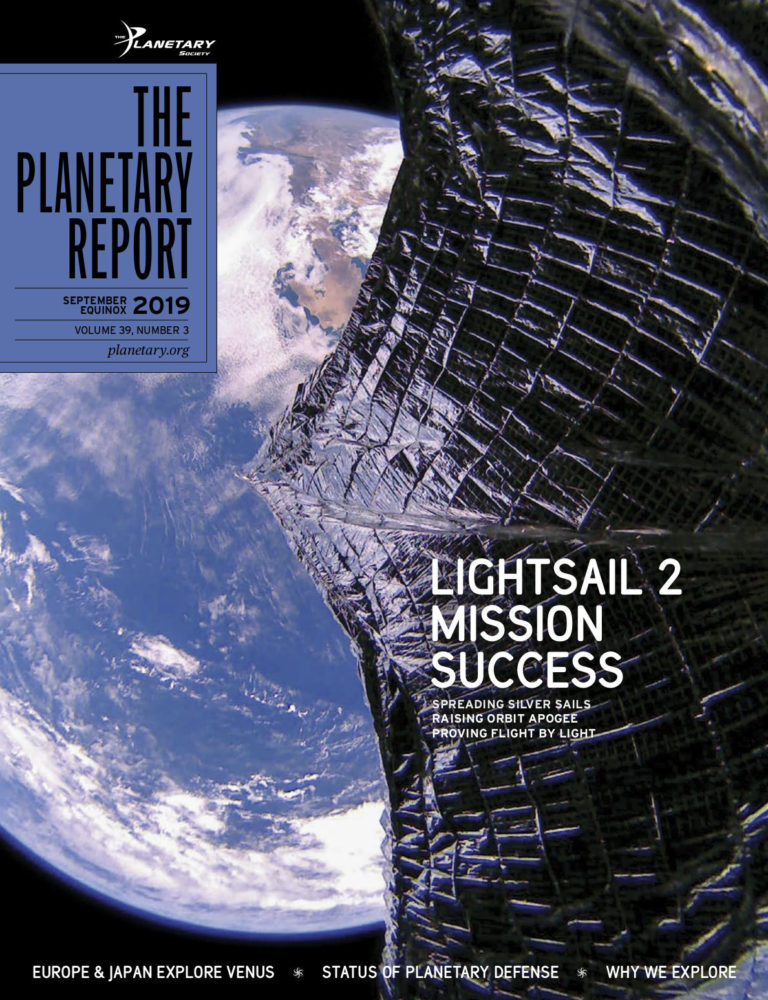
On the Cover: LightSail 2 documented half of its fully deployed sail as it passed over Baja California within sight of its San Luis Obispo ground station on 31 July 2019. The sail, which is actually square, appears warped because of the camera’s 185-degree fisheye lens.
Download PDF
CONTENTS
Javier Peralta plumbs the depths of Venus’ atmosphere through the eyes of the Venus Express and Akatsuki orbiters.
Vishnu Reddy delivers a sober but hopeful report on our understanding of near-Earth objects, their dangers, and our readiness.
Space on Earth
Mooncraft
A view of a clean room in India.
A beautiful composite of Dione images from Cassini.
Your Place In Space
Mission Success!
Bill Nye shares his joy—and gratitude—for LightSail 2’s flight.
Celebrate your LightSail 2 success!
Get Involved
Day of Action
Find out how to participate in space exploration.
Bruce Betts looks forward to a rare transit of Mercury.
Emily Lakdawalla brings us up to date with all the robots traveling beyond Earth.
This new column looks at the human side of planetary exploration–and the myriad reasons we look to the heavens.
Mooncraft: Putting the Finishing Touches on a Founder’s Dream
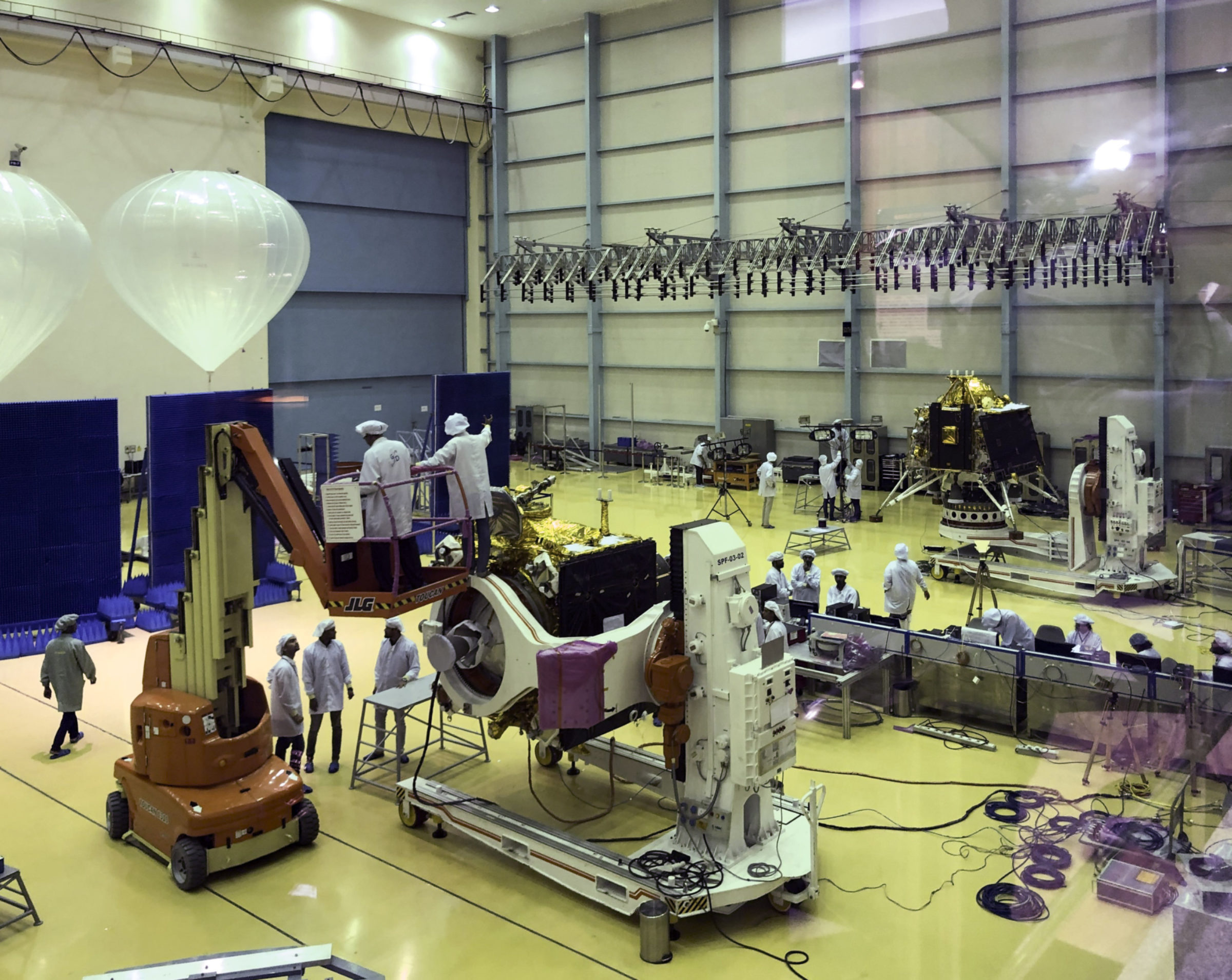
Before spacecraft can take flight, thousands of people spend years working on Earth to turn dreams into hardware. The assembly facility at the Indian Space Research Organisation (ISRO)’s Satellite Integration and Test Establishment buzzes with activity as workers prepare for Chandrayaan-2’s launch to the Moon. Near the center is the Chandrayaan-2 orbiter, mounted on a rotating test stand. In the background on the left, 2 helium-filled balloons await use in the testing of the lander and rover; their buoyancy can counteract a spacecraft’s Earth weight to simulate lunar surface gravity. To the right stands the large Vikram lander, named for Vikram Sarabhai (1919-1971), who founded numerous Indian research institutes and advocated the establishment of an Indian space program.
ISRO treated local media to a rare glimpse of the clean room facility on 12 June 2019. This photo was taken from the viewing gallery by Sandhya Ramesh, science editor for ThePrint India. On 22 July, both orbiter and lander successfully launched toward the Moon. Vikram aims for a 7 September landing; its fate is unknown as of the time this magazine went to print. If successful, India would be only the fourth nation to soft land on the lunar surface.
Snapshots From Space
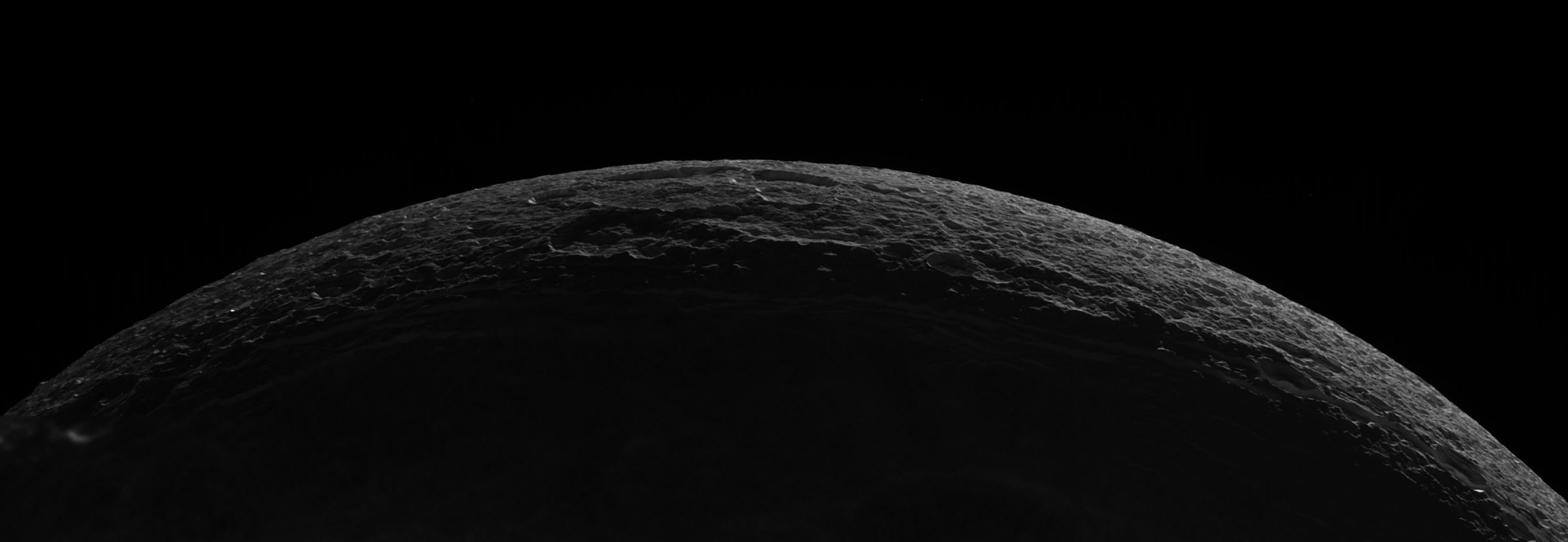
When the Voyagers viewed Dione from afar, they saw “wispy terrain”—bright scratches of unknown origin across the surface. Cassini got a lot closer to Dione on 11 October 2005 and observed the “wisps” to be bright ice exposed along steep-walled fractures. To craft this view, Justin Cowart assembled 7 high-resolution images of the sunlit crescent of Dione onto a lower-resolution view that included some detail on Dione’s nightside where it’s lit by Saturnshine.
See more amateur-processed space images.
Mission Success!
LightSail 2 Demonstrates Flight by Light
Bill Nye is chief executive officer of The Planetary Society. Read the full article
What a journey! What a success! Your LightSail 2 spacecraft is in space, controlling its orbit solely on the power of sunlight.
Along with a few hundred fellow members, I was at the night launch of LightSail 2 on 25 June 2019. A SpaceX Falcon Heavy rocket took us to orbit. It was spectacular.
One week later, our CubeSat deployed and began its adventure in space. Three weeks after that, we were sailing! As I write, LightSail 2 is building orbital altitude by hundreds of meters per day.
LightSail 2 is part of our legacy and a dream come true. Back in the 1970s, as comet 1P/Halley was on its way toward the Sun, our founders Carl Sagan, Bruce Murray, and Louis Friedman advocated for a solar sail mission to catch up with it. Carl showed the idea to Johnny Carson on The Tonight Show. It was an inspiring concept, but it never got off the drawing board.
Then, in 1999, The Planetary Society, partnering with Russian space companies and Ann Druyan’s Cosmos Studios, began work on the Cosmos 1 solar sail. Cosmos 1 could have been the first demonstration of solar sailing, but the rocket failed, and the spacecraft ended up in the sea.
We might have given up on the dream were it not for all of you—our members. You responded with a resounding “try again,” and now we’re sailing in space. Thanks to you, LightSail 2 is flying and proving the concept of flight by light. As a member, you appreciate how hard it is to design, build, test, retest, and finally fly a space mission. For the first time in history, we demonstrated fast tacking, twice in every 100-minute orbit, near Earth—with a spacecraft propelled by sunlight. LightSail 2 is extraordinary—and, we hope, precedent setting. Your passion and commitment got us here. Together, we have accomplished something wonderful. Sail on!

For more about LightSail, including videos, detailed stories, more images, and how to track LightSail 2, go to sail.planetary.org.
Your Impact
Get Involved
Day of Action in Washington, D.C.
Mark your calendars: we’re mobilizing citizen space advocates to support space science and exploration in Washington, D.C. on 9-10 February 2020.
Experience the thrill of advocating for NASA face to face alongside your fellow Planetary Society members. Early-bird registration ends 31 December 2019. Register today! planetary.org/dayofaction
Mission Control Dashboard
You made the LightSail 2 mission possible. Now, you can track it in real time as it sails around Earth.
All the latest health and status information is available for download. Mission Control also helps you see when LightSail 2 will fly over your location. Sail watchers are most likely to see the shiny spacecraft at dawn or dusk. planetary.org/missioncontrol
Did you spot the sail? Tell us at [email protected]!
LightSail Mission Outreach Toolkit
As a Planetary Society member, you’ve made history with the successful solar sailing demonstration by LightSail 2. Now, you can spread the word about LightSail in your own community. We’ve made it easy for you to inspire others about what is possible when everyday citizens come together to make the extraordinary happen. Download resources at planetary.org/volunteer.
The Countdown to the Holidays Has Begun!
Here are 3 easy ways you can support space exploration while checking off your holiday gift list this year:
Shop to Support: From T-shirts to mission patches, every purchase from our official store supports vitally needed work to advance space exploration through advocacy, education, innovation, and global collaboration. planetary.org/shop
Give the Gift of Space: Share your passion for space exploration by giving someone special a gift membership to The Planetary Society. It’s the perfect way to introduce your loved one to an inspiring new level of participation in space exploration. planetary.org/gift
AmazonSmile: You Shop. Amazon Gives. Did you know you can give back to space exploration every time you shop on Amazon? Select The Planetary Society as your AmazonSmile charitable organization, and Amazon will donate 0.5 percent of every eligible purchase. amazon.com/smile
Need more ideas? Check out our annual gift guide at planetary.org/giftguide
International Podcast Day
International Podcast Day on 30 September celebrates how podcasts connect us to new people, ideas, and stories each day, worldwide. This year, celebrate by listening to Planetary Radio, hosted by Mat Kaplan. Our weekly program brings you the voices of the fascinating people who make space exploration happen. You can help spread the word by using the hashtag #InternationalPodcastDay. planetary.org/radio
Your Apollo Stories
For the fiftieth anniversary of Apollo 11, The Planetary Society asked you for your thoughts and memories of this epochal event. Below is a sampling of those stories. Add your own story or read more at planet.ly/apollostory.
“It was my eighth birthday my parents let me stay up late to watch the moon walk. I remember President Nixon’s phone call and asking my dad if we could call the astronauts after the president hung up. He said he didn’t know the number, but it was probably a long-distance call anyway.” – Tim P.
“I first came to know about [Apollo] in school, and by then, landing on the Moon was a thing taken for granted...I never thought about how these things developed, and now that I know their history, I really feel lucky to live in a tremendously technological world where we get so many facilities to study our universe. No doubt this all started with Apollo.” – Sabiba H.
“I was enthralled. My family and I were glued to the set. I was taken by the world’s different reactions to the landing. The Dutch sat in chairs and applauded, and the Italians were dancing around and shouting. I had to notice–I’m an anthropologist–but I too was energized. I was 48 at the time and an enthusiastic sciencefiction fan since I was a child. Incidentally, that is why I joined The Planetary Society right off.” – Lillian A.
“The moment Neil Armstrong reached the surface of the Moon and spoke the historic words, my cousin looked around at me with the biggest grin I believe I have ever seen in my life It must have been a direct reflection of the grin I had on my face at the time.” – Jim V.
What's Up?
By Bruce Betts
In the Sky
A rare transit of Mercury across the Sun occurs on 11 November. To observe Mercury’s small disk crossing the Sun, you’ll need a telescope with proper safety filters, or you can tune in to telescope webcasts. This transit will be visible from South America and Africa and most of North America and Europe. The Geminids meteor shower peaks 13 and 14 December, but a full Moon at the peak will limit the number of meteors visible. Bright Jupiter dominates the western sky until even-brighter Venus starts appearing low in the West in October and November. These two brightest star-like objects in the night sky will be close together on 24 November. Yellowish Saturn is to their upper left, and the crescent Moon will join the group on 28 November. By November, reddish Mars begins to rise in the pre-dawn East.
Random Space Fact
Mercury transits the Sun an average of 13.4 times per century. After 2019, the next transit of Mercury across the Sun will not take place until 2039.
Trivia Contest
Our March equinox contest winner is Peter Yanginski of Deerfield, New York. Congratulations! The question was: On what planet in our solar system have the fastest wind speeds been measured? The answer: Neptune, where wind speeds as high as 2,200 km/h (1,400 mph) have been measured.
Try to win a copy of Super Cool Space Facts: A Fun, Fact-filled Space Book for Kids by Bruce Betts and a Planetary Radio T-shirt by answering this question:
As seen from Earth, in what year was the last transit of Mercury across the Sun?
Email your answer to [email protected] or mail your answer to The Planetary Report, 60 S. Los Robles Ave., Pasadena, CA 91101. Make sure you include the answer and your name, mailing address, and email address (if you have one). By entering this contest, you are authorizing The Planetary Report to publish your name and hometown. Submissions must be received by 1 December 2019. The winner will be chosen in a random drawing from among all the correct entries received.
For a weekly dose of “What’s Up?” complete with humor, a weekly trivia contest, and a range of significant space and science-fiction guests, listen to Planetary Radio at planetary.org/radio.
Where We Are
An At-A-Glance Spacecraft Locator
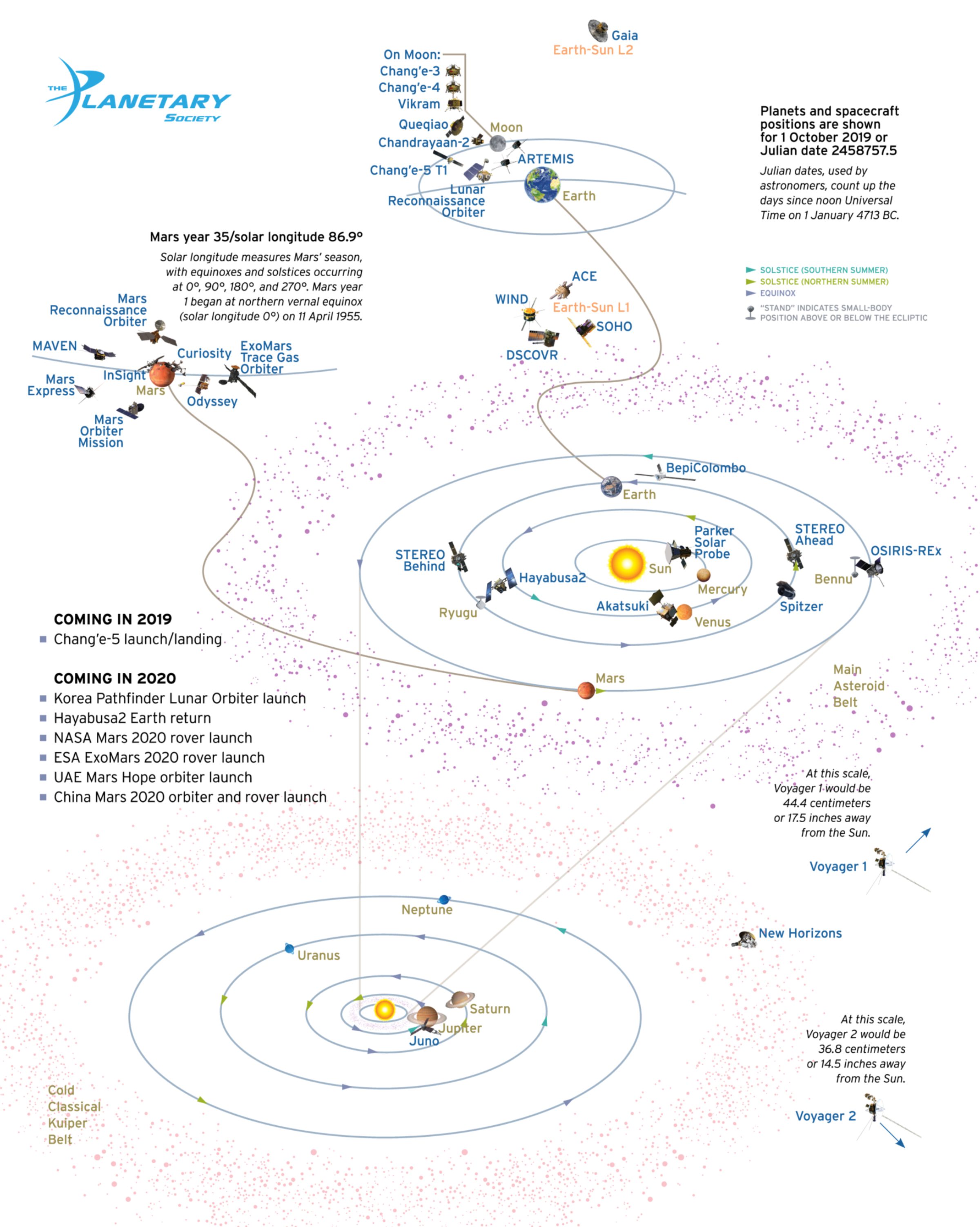
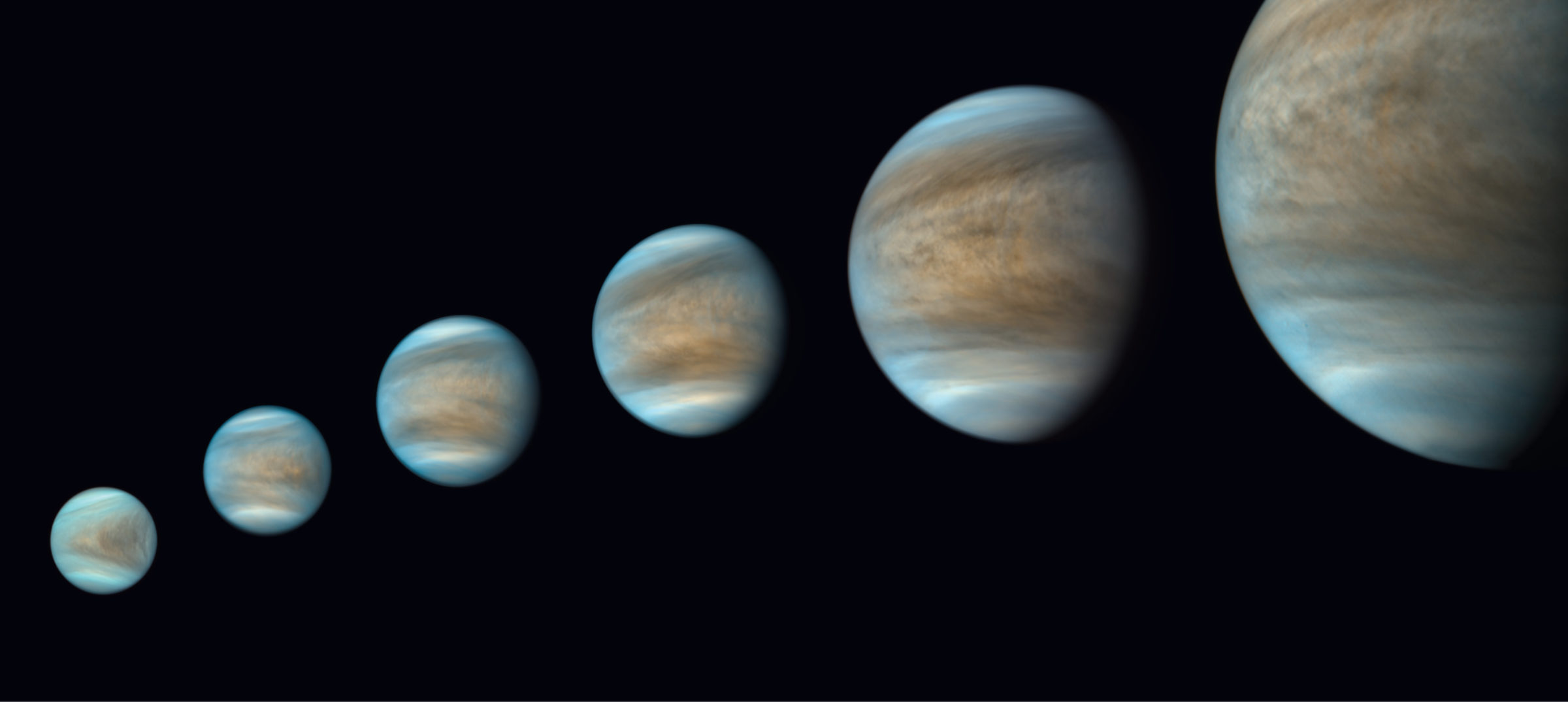
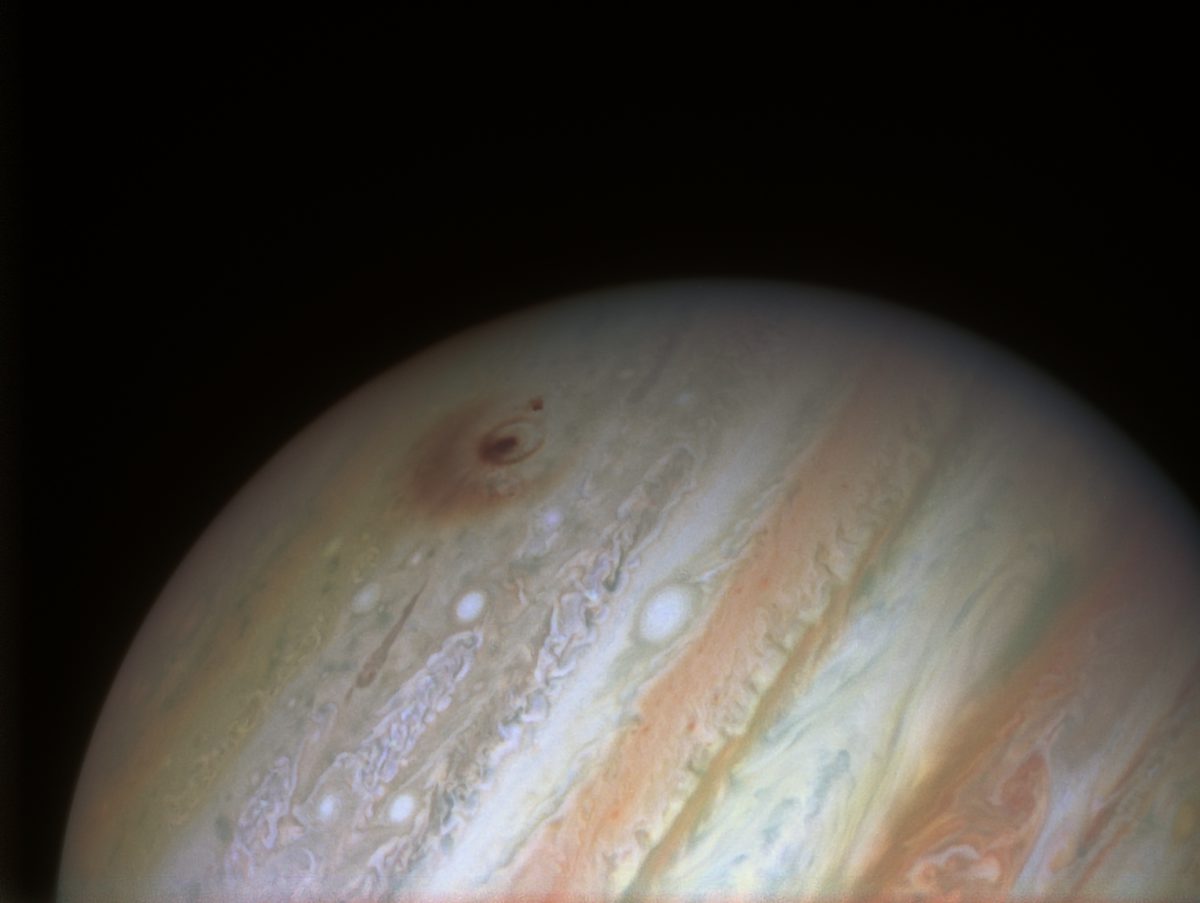
Astronomical Art
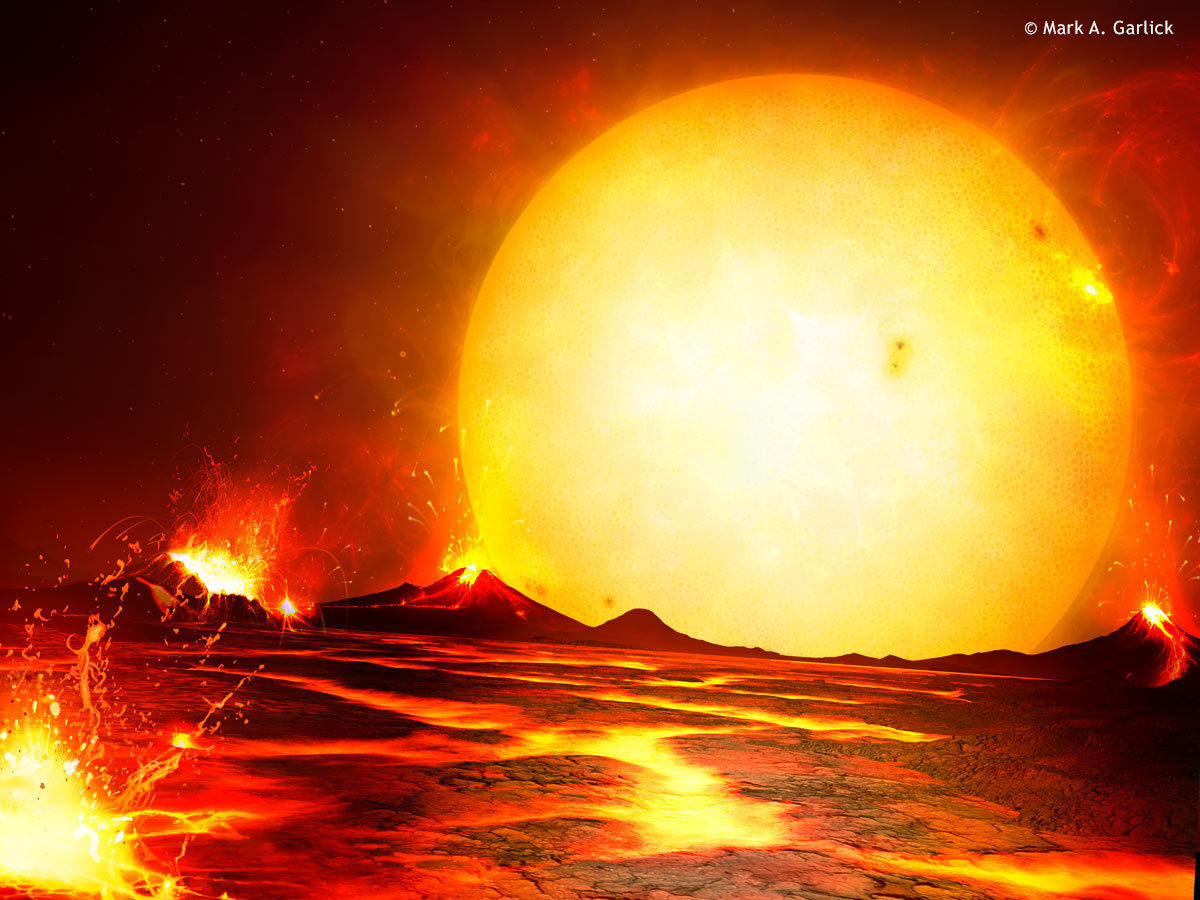
The Planetary Report • September Equinox 2019
Help advance space science and exploration! Become a member of The Planetary Society and you'll receive the full PDF and print versions of The Planetary Report.


 Explore Worlds
Explore Worlds Find Life
Find Life Defend Earth
Defend Earth

